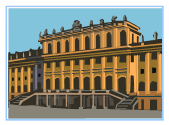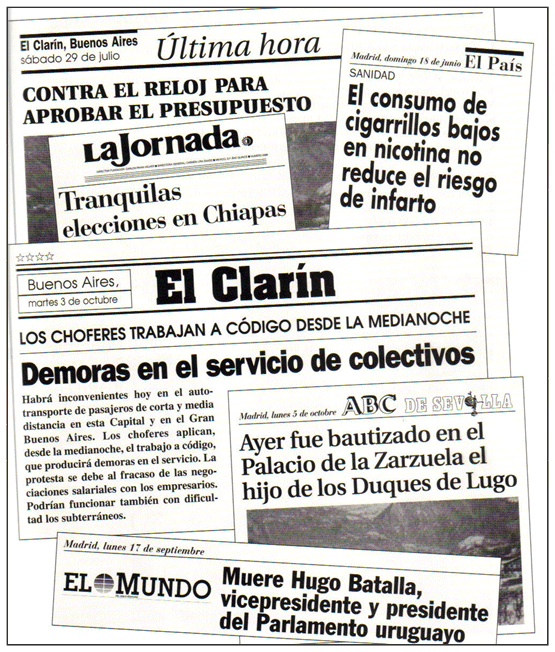El Artículo
Unit Overview

In this unit, the student will learn when to omit articles before nouns and to add articles to speak, generally. The student will also learn new words and phrases to show that one greatly dislikes something and to read headlines from several Spanish newspapers, in the target language.
1. ¿LO SABÍAS...?
En la mayoría de los países hispanohablantes, los automóviles y la gasolina son excesivamente caros. Por esta razón es muy popular la motocicleta, especialmente entre la gente joven.
2. REPASO
Indefinite Article (Artículo indefinido)
When the verb ser is followed by a noun denoting profession or nationality, the indefinite article is not used.
La señora Sánchez es doctora. |
Mrs. Sanchez is a doctor. |
Juan Huachi es viudo. |
Juan Huachi es a widower. |
La señorita Martín es maestra. |
Miss Martín es a teacher. |
NOTE…if the noun following ser is modified, an indefinite article must be used.
La señora Bernales es una viuda muy joven. |
Mrs. Bernales is a very young widow. |
La señorita Robles es una abogada muy hábil. |
Miss Robles is a very able lawyer. |
Talking about days of the week
The definite article is used with days of the week, in Spanish, to represent “on”.
Tienes clases los martes. |
You have classes on Tuesdays. |
El viernes vamos al campo. |
On Friday we’re going to the country. |
3. VOCABULARIO NUEVO

Nouns:
el alcázar
castle
el aumento
increase
la bolsa
bag
el cautivo
prisoner
el chófer
chauffer
el colectivo
bus
la demora
delay
el golpe
hit
el infarto
heart attack
la laguna
lake
la mentira
lie
la mezquita
mosque
el monte
mountain
el moro
Arab
la muerte
death
el reloj
watch,
el rey
king
el riesgo
danger
la vida
life
la viuda
widow
Adjectives:
amueblado(a)
furnished
enfadado(a)
angry
helado(a)
iced
listo(a)
ready
relleno(a)
stuffed
sabroso(a)
delicious
tinto(a)
red, ripe
Verbs:
aprobar
to approve
casarse
to get
fracasar
to fail
gritar
to yell
labrar
to work
nacer
to be
reducir
to decrease
Useful Expressions:
a menos que
unless
al día siguiente
the following day
al mismo tiempo
at the same time
en vez de
instead of
encantarle a uno
to love someone
hacer caso
to pay attention
medio día
part-time
se alquila
for rent
tomar una decisión
to make a decision
4. LENGUAJE
If you want say that you greatly dislike something, you can say:

La odio. |
|
La aborrezco. |
|
To say why you don’t like it, you can say:
Lo encuentro detestable. |
|
Lo encuentro repugnante. |
|
Me da asco. |
|
Lo encuentro abominable. |
|
5. ESTRUCTURA
El Artículo
When speaking about a person in Spanish, the definite article must be used with a title.
La señora Prada es abogada. |
Mrs. Prada es a lawyer. |
If you are speaking directly to the person, the definite article is not used with a title.
-Hola, Don Flores. |
-Hasta luego, señora Ortega. |
Special uses of the Article
In Spanish, the definite article is necessary before nouns used generally or abstract nouns. In English, we do not use an article with generic nouns. Compare the Spanish and English sentences.
La bondad es una virtud. |
Kindness is a virtue. |
La gente tiene que comer. |
People have to eat. |
Los mendigos son pobres. |
Beggars are poor. |
Articles with Reflexive Verbs
When referring to body parts or articles of clothing in Spanish, you use the definite article with the reflexive pronoun.
Ella se lava las manos antes de comer. |
She washes her hand before eating. |
Te cepillas los dientes y te lavas la cara. |
You brush your teeth and wash your face. |
In English, the object noun is usually in the plural form when the subject is plural. However, in Spanish, the noun is always singular. The singular form is used to show that each person is in possession of one object. Take a look at the examples:
Ellos se ponen el casco para trabajar. |
They put on their hardhats to work. |
Nosotros no quitamos la corbata y la gorra. |
We take off our ties and caps. |
6. PERIODISMO
Read the headlines below from several Spanish newspapers to see if you can figure out what the articles will include.
Después de leer, vámonos a las preguntas.

